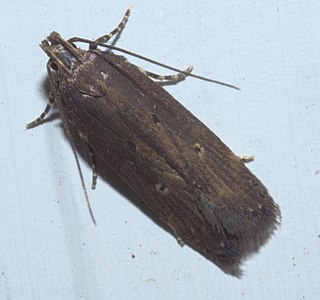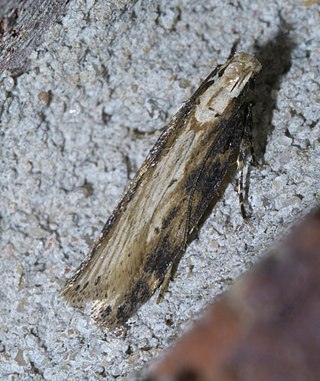
Chionodes is a genus of moths of the family Gelechiidae. It is distributed throughout much of the world. The larvae of many species use the Douglas fir as a host plant.
Chionodes petalumensis is a species of moth in the family Gelechiidae. It is found in North America from southern British Columbia to California, Arizona and Colorado.

Chionodes discoocellella, the eyeringed chionodes moth, is a moth in the family Gelechiidae. It is found in the United States, where it has been recorded from Maine to South Dakota, Florida, Texas and Colorado.

Chionodes fuscomaculella is a moth in the family Gelechiidae. It is found in North America, where it has been recorded from Nova Scotia and Quebec to Florida, south-western Wisconsin, eastern Texas and eastern Oklahoma.
Chionodes gilvomaculella is a moth in the family Gelechiidae. It is found in North America, where it has been recorded from Nova Scotia and southern Ontario to West Virginia and Ohio.
Chionodes helicosticta is a moth in the family Gelechiidae. It is found in North America, where it has been recorded from Texas, Arizona, California and Oregon.

Chionodes hibiscella is a moth in the family Gelechiidae. It is found in North America, where it has been recorded from Connecticut and Illinois to South Carolina, Louisiana, Mississippi and Texas.

Chionodes obscurusella, the boxelder leafworm moth, is a moth in the family Gelechiidae. It is found in North America, where it has been recorded from Nova Scotia to Manitoba, south to North Carolina and Oklahoma.
Chionodes pereyra is a moth in the family Gelechiidae. It is found in North America, where it has been recorded from Massachusetts and Michigan to Florida and Texas.
Chionodes pinguicula is a moth in the family Gelechiidae. It is found in North America, where it has been recorded from Utah, Colorado, Texas, New Mexico, Arizona, Nevada and California.
Chionodes psiloptera is a moth in the family Gelechiidae first described by William Barnes and August Busck in 1920. It is found in North America, where it has been recorded from Quebec to British Columbia and then to Alaska, eastern Washington, Montana and New York.
Chionodes whitmanella is a moth in the family Gelechiidae. It is found in North America, where it has been recorded from south-western Manitoba and eastern Washington to Colorado, Arizona and California.
Chionodes johnstoni is a moth in the family Gelechiidae. It is found in North America, where it has been recorded from California. The Global Lepidoptera Names Index has it as a synonym of Chionodes gilvomaculella.
Chionodes scotodes is a moth in the family Gelechiidae. It is found in Sonora, Mexico.
Chionodes chlorocephala is a moth in the family Gelechiidae. It is found in North America, where it has been recorded from New Mexico, California and Mexico.
Chionodes perissosema is a moth in the family Gelechiidae. It is found in Argentina.
Chionodes tannuolella is a moth in the family Gelechiidae. It is found in southern Siberia.
Chionodes sagayica is a moth in the family Gelechiidae. It is found in Russia. The Global Lepidoptera Names Index has this species as a synonym of Chionodes fumatella.
Chionodes spirodoxa is a moth in the family Gelechiidae. It is found in Brazil.
Chionodes xylobathra is a moth in the family Gelechiidae. It is found in Venezuela.




